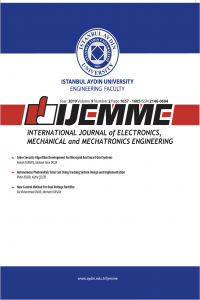USAGE OF PICTOGRAMS TO INTRODUCE MUSICAL INSTRUMENTS TO EDUCABLE MENTALLY RETARDED CHILDREN AS AN ALTERNATIVE METHOD
USAGE OF PICTOGRAMS TO INTRODUCE MUSICAL INSTRUMENTS TO EDUCABLE MENTALLY RETARDED CHILDREN AS AN ALTERNATIVE METHOD
Mentally retarded children, pictogram, 2d character design, computer aided drawing, auditory perception visual perception, music,
___
- Senemoglu, N., “Development, Learning and Teaching, From Theory to Practice”, Pegem Academy, Ed. 20th, Ankara, pp. 292-293, 2011. (in Turkish)
- Ayata, E., “Music and Brain” , PhD Thesis; Istanbul Technical University, Instıtute of Social Science, Istanbul, p.30, 2008. http://www.onlinecolleges.net/2012/06/20/music- learning, 05.02.2014.
- Sazak, N., (2008), “Basic Dimensions of
- Musical Perception”, Journal of Human Sciences, vol. 5, no. 1., p.11, 2008. (in Turkish)
- Ozsoy, V., “Visual Arts Education, Historical and Philosophical Foundations of Art Education”, Gunduz Education and Pub., Ankara., pp. 42-43, (in Turkish) Baser, M. , “Pictograms and Symbols in Visual Communication Effects on Human”, Thesis of Masters Degree, Anadolu University, Social Science Inst. Eskisehir., p. 13, 1994. (in Turkish)
- Sharma, M., “Special Education Music Therapy”, APH Publishing Corporation, New Delhi, India, p.72, 2007.
- Turnbull, R., Turnbull, A., Shank, M., Smith, S., J., “Exceptional Lives, Special Education in Today’s Schools”, Fouth Ed., Pearson, Merril Prentice Hall, USA, p.237, 2004.
- Ozsoy, Y., Ozyurek, M., Eripek , S., “Introduction to Children in Need of Special Education-Special Education”, Karatepe Pub., Ankara, pp.164-165, 2001. (in Turkish)
- Bray, N., W., Fletcher, K., L., Turner, L.,A., “Cognitive Competencies and Strategy Use in İndividuals with Mental Reterdation”, ed., W.W. Maclean Jr., Ellis’ Handbook Ofmental Deficiency, Psychological Theory, and Research, Third ed., pp.197-212, 1997.
- Ozgur, I, “Education of Children with Disabilities and Special Education”, Karahan Pub., Adana, pp.189-190, 2008. (in Turkish)
- Goksu, I., Cevik, T., “Introduction to Special Education” , Adana, 2004. (in Turkish)
- Wigram, T., Pedersen, I., N., Bonde, O., L., “A Comprehensive Guide to Music Therapy”, Jessica Kingsley Pub., England, pp. 29-30, 2002.
- Coban, A., “Music Therapy, Musical Therapy for Pschological Health”, Timas Pub., Istanbul, (in Turkish) Wigram, T., “The Psychological and Physiological Effects of Low Frequency Sound and Music”, Music Therapy Perspectives, Vol 13(1), Special Issue: International Music Therapy, pp. 16- , 1995.
- Iftar, K., G., Birkan, B., Uysal, A., “Teaching the Concept of Mind to Disabled Children” ,Ankara, p. 7, 2005. (in Turkish)
- Günsu YILMA, Bahadır UÇAN, “A study based on the perceptibility of musical enstruments of mentally handicapped children with visual support” (in Turkish) 2014 Volume 4 Issue 1
- ISSN: 2146-0604
- Başlangıç: 2011
- Yayıncı: İstanbul Aydın Üniversitesi
SUBSTRATE INTEGRATED WAVEGUIDE BAND-PASS FILTER WITH CPWG FED FOR RADAR APPLICATION IN X-BAND
Abbas AYARAN, J. Bagheri K., S. GOLMOHAMMADI3
UWB RADAR IN HIDDEN HUMAN DETECTION
Saeid KARAMZADEH, Mesut KARTAL
EVALUATION OF PRIVATE SCHOOL LOCATION IN THE ISTANBUL METROPOLITAN AREA
Mehmet TOPÇU, Fatih TERZİ, N. İpek ÇETİN, Vedia DÖKMECİ
EVALUATION OF COMPUTER ALGEBRA SYSTEMS USING FUZZY AHP
Ilham N. HUSEYINOV, Feride S. TABAK
ANALYSIS AND PERFORMANCE MEASUREMENT OF EXISTING SOLUTION METHODS OF QUADRATIC ASSIGNMENT PROBLEM
Morteza KARAMI, Sadegh NIROOMAND, Nima MIRZAEI, Bela VIZVARI
FORMATION OF WATERSIDES ON THE BOSPORUS AND SPATIAL DEVELOPMENT OF BOSPORUS WATERSIDE GARDENS
PARAMETER TESTS FOR IMAGE SEGMENTATION OF AN AGRICULTURAL REGION
THE DETERMINATION OF GREEN AREAS IN CITY FROM THE VIEW POINT OF CITY FURNITURE IN EMINONU
